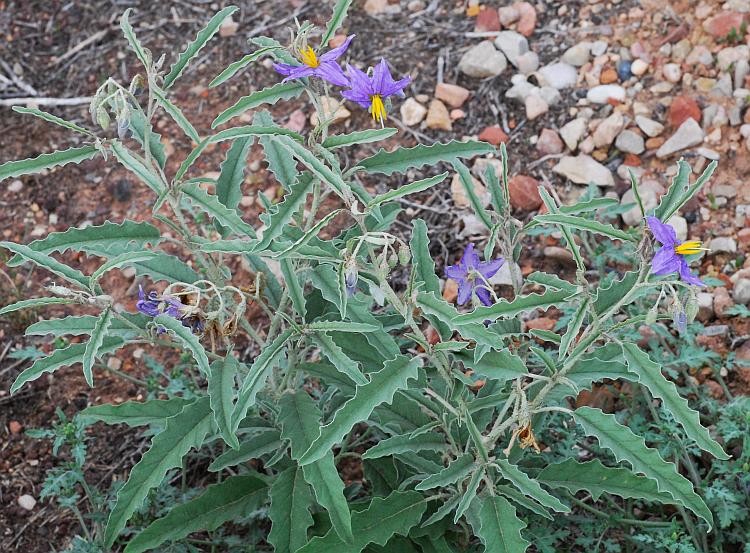Solanum elaeagnifolium Cav.
White Horse Nettle

Native
CC = 1
CW = 5
MOC = 9
© SRTurner
Solanum elaeagnifolium Cav.White Horse Nettle | |
 |
Native CC = 1 CW = 5 MOC = 9 |
© SRTurner |
|
Family - Solanaceae Habit - Perennial forb with deep, long-creeping rhizomes. Stems - Ascending to erect, to 70 cm, often branched, densely pubescent with stellate, nonglandular hairs (these a mixture of sessile and short-stalked, with 9-13 branches), the green tissue totally obscured by the densely matted, silvery-white hairs; unarmed or more commonly armed with scattered, slender, straight, tan to orangish brown prickles 1-4 mm long.
Leaves - Alternate, simple, petiolate, unarmed or with scattered, short prickles, mostly along the petiole and midvein. Petioles unwinged, densely stellate-hairy, the hairs sessile, with 9-13 branches). Leaf blades 3-10 cm long, simple, narrowly lanceolate to oblong-lanceolate or narrowly oblong, angled to a bluntly or sharply pointed tip, obliquely rounded to more commonly tapered at the base, the margins entire or shallowly to moderately wavy, the surfaces densely pubescent with stellate hairs, the green tissue totally obscured by the densely matted, silvery-white hairs.
Inflorescences - Axillary near the stem tips, of solitary flowers or more commonly racemes, the axis with sparse to moderate, short prickles, pubescent similar to the stems, elongating as the fruits develop) of 3-7 flowers, the flower stalks not jointed, slender to moderately stout, thickened toward the tip.
Flowers - Calyces 9-14 mm long at flowering, the tube somewhat 5-angled at flowering, the tube spreading or only loosely cupping the base of the fruit, deeply 5-lobed at flowering, the lobes as long as to longer than the tube, slightly unequal, linear above a triangular base, the outer surface unarmed or with only scattered small prickles toward the base, also densely stellate-hairy. Corollas saucer-shaped, 10-16 mm long, purple to bluish purple or lavender, lobed to at or above the midpoint, the lobes broadly ovate-triangular, sometimes appearing minutely wavy or irregular along the margins, tapered abruptly to bluntly or sharply pointed tips, spreading at flowering, the inner surface glabrous, the outer surface stellate-hairy. Anthers equal, 6-9 mm long, narrowly oblong, yellow, dehiscing by terminal pores. Ovary 2-locular, the surface stellate-hairy, the style slightly exserted from the anther ring.
Fruits - Berries 1.0-1.5 cm long, globose, lacking stony granules, yellow turning black with age, dull to somewhat shiny, unarmed, glabrous or sparsely stellate-hairy. Seeds 3-5 mm in longest dimension, broadly ovate to broadly oblong in outline, sometimes bluntly angular, moderately flattened, unwinged, the surface smooth or very slightly few-wrinkled, brown to dark brown or grayish brown, dull or somewhat shiny.
Flowering - July - September. Habitat - Glades, upland prairies, bluff tops, margins of salt springs, pastures, railroads, open disturbed areas. Origin - Native to the U.S. Lookalikes - Distantly, Solanum dulcamara. Other info. - This species is uncommon in Missouri, so far collected from only nine widely-scattered counties. Its U.S. distribution is primarily southwestern, and it is very common in many states to our west. There is disagreement whether the plant is native in these areas or not. Although S. dulcamara is listed as a lookalike, this is only because both species have purple flowers of the Solanum morphology. The silvery foliage and wavy-margined leaves of Solanum elaeagnifolium are quite distinctive. The plant is also normally spiny, but this is somewhat variable. Photographs taken in Zion National Park, Washington County, UT, 9-2-2013, at San Pedro Riparian Corridor, Cochise County, AZ, 5-27-2016, and at Blue River hunting reserve, Johnston County, OK, 7-26-2016 (SRTurner). |